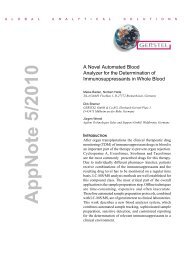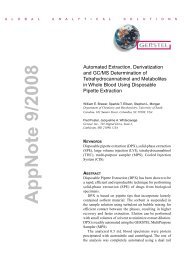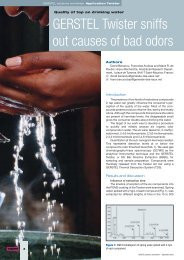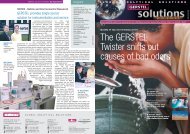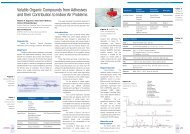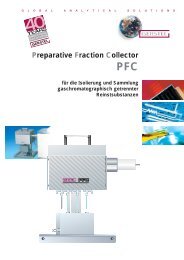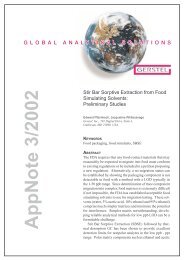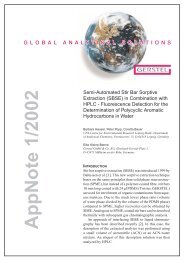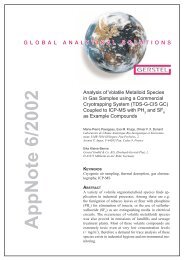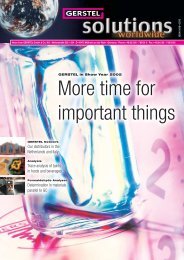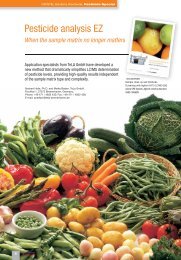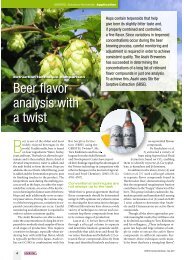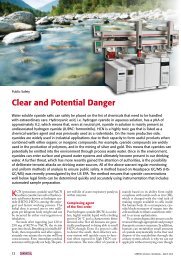GERSTEL Solutions No. 7 (pdf; 1,86 MB)
GERSTEL Solutions No. 7 (pdf; 1,86 MB)
GERSTEL Solutions No. 7 (pdf; 1,86 MB)
You also want an ePaper? Increase the reach of your titles
YUMPU automatically turns print PDFs into web optimized ePapers that Google loves.
<strong>GERSTEL</strong> <strong>Solutions</strong> Worldwide Report<br />
profit rules the market and dictates taste;<br />
science becomes the tool to help tailor the<br />
wine to meet the trend. Slightly more black<br />
currant flavor here, a little more freshness<br />
there: Currently, fruity, moderately sparkling<br />
wines are popular. These can be produced<br />
by growing wine under cooler conditions<br />
at higher elevations or by fermenting<br />
the grape juice at lower temperatures.<br />
Many wine growers consider wine design<br />
that follows such market requirements<br />
a potential problem. What limits should we<br />
impose on wine design? The limits of most<br />
in the industry were certainly crossed when<br />
employees of a South African winery added<br />
bell pepper flavor to the wine. To most wine<br />
professionals, adulterating wine with flavors<br />
foreign to the species is nothing short<br />
of sacrilege. Some companies have contemplated<br />
diluting strong red wines with water<br />
since customers are less interested in wines<br />
with high alcohol levels. In Geisenheim,<br />
stricter rules apply concerning the limits<br />
for designer wines. „If this trend continues,<br />
we will approach a situation where only<br />
synthetic mass products are available”, says<br />
Klaus Schaller, head of the research institute.<br />
The thought is clearly not appealing<br />
to the seasoned oenologist.<br />
A seasoned gut feeling<br />
and intuition to hit that<br />
special note<br />
Then what is the noble art of wine making?<br />
First of all, it requires expertise on the effects<br />
of growing conditions, sunlight, and<br />
soil quality, susceptibility to diseases, fungi<br />
and pests. „When it comes to the really<br />
important decisions, I use my gut feeling:<br />
You cannot produce a good wine without<br />
a healthy dose of creativity“, says Rowald<br />
Hepp, who grows only Riesling in his<br />
vineyard “Schloss Vollrads”, according to<br />
the magazine ‘Capital’ among the top one<br />
hundred in the world. „To create wine with<br />
individual personality, you need to go beyond<br />
science and call on your intuition“,<br />
says Carlos Moro, a winegrower from<br />
Spain.<br />
For amateurs, the basics may be comprehensible:<br />
Taste and flavor is controlled<br />
by maturing the wine in a barrel under<br />
the influence of yeast. The details of how<br />
to influence the fermentation to provide<br />
top wines, however, is still more of an art<br />
than a science, understood only by master<br />
wine makers, each with his or her well<br />
kept secrets.<br />
If wine growers are forced to conform<br />
to mass market tastes, “the<br />
growers and wine makers that thrive<br />
on authenticity will not survive in the<br />
long run”, warns Klaus Schaller.<br />
Just a single evening spent in good<br />
company sampling a wide variety of<br />
wines served in proper glasses can<br />
give you an impression of the word<br />
“authentic”, and why it is worth preserving.<br />
<strong>GERSTEL</strong> Olfactory Detector Port ODP<br />
Visualizing odor intensities<br />
Identifying flavor compounds or compounds that cause offodors<br />
are tasks that quickly expose the limitations of standard<br />
instruments and methods. The <strong>GERSTEL</strong> Olfactory Detector<br />
Port (ODP) allows sensing of compounds by the human nose<br />
as they elute from the column of a gas chromatograph, but<br />
the most powerful means of identifying flavors, fragrances<br />
and off-odors incorporates the addition of a mass spectrometer.<br />
For this technique, the effluent is split as it leaves the<br />
column so that it arrives simultaneously at the nose and the<br />
mass spectrometer, providing both sensory and chemical<br />
identification.<br />
A voice recognition software package provides a detailed<br />
“olfactogram” that includes odor intensity, retention<br />
time and voice comments for compounds as they elute. All<br />
data is stored with the Agilent ChemStation results and can<br />
be presented in a number of different ways. Among these<br />
are overlapping chromatograms and olfactograms and data<br />
reports with descriptors, that help with data interpretation<br />
and problem solving.<br />
14<br />
<strong>GERSTEL</strong> <strong>Solutions</strong> Worldwide – May 2007



